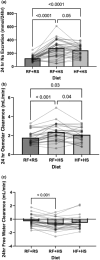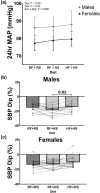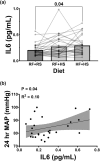The impact of dietary sodium and fructose on renal sodium handling and blood pressure in healthy adults
- PMID: 40129273
- PMCID: PMC11933718
- DOI: 10.14814/phy2.70284
The impact of dietary sodium and fructose on renal sodium handling and blood pressure in healthy adults
Abstract
Increased dietary sodium is linked to hypertension, but most young adults display "sodium-resistant" blood pressure (BP), meaning BP is not elevated with sodium loading. In sodium-resistant rodents, fructose induces salt-sensitive BP via increased renal sodium reabsorption. Therefore, we tested the impact of fructose and sodium on renal sodium handling and BP in healthy adults, hypothesizing that their combination would impair sodium excretion and increase BP. Thirty-six participants enrolled in a randomized, double-blind, crossover trial involving three diets varying in fructose and sodium. On day 7, participants wore ambulatory BP monitors and collected 24-h urine. Although high sodium increased urinary sodium excretion, excretion was 15% lower with high fructose plus high salt versus high salt alone (235.1 ± 85.0 vs. 277.9 ± 121.2 mmol/24 h, p = 0.05). Compared to the recommended diet, high salt alone did not significantly change 24 h. MAP; however, high fructose plus high salt modestly raised 24 h MAP (81 ± 6 vs. 84 ± 7 mmHg, p = 0.03). High fructose and high salt increased serum interleukin-6 concentrations compared to the recommended diet (0.31 ± 0.2 vs. 0.24 ± 0.19 pg/mL, p = 0.04). These findings suggest that increased sodium and fructose alter renal sodium handling and BP in young adults.
Keywords: Blood Pressure; Fructose; Renal Function; Salt.
© 2025 The Author(s). Physiological Reports published by Wiley Periodicals LLC on behalf of The Physiological Society and the American Physiological Society.
Conflict of interest statement
No conflicts of interest, financial, or otherwise, are declared by the authors.
Figures





Similar articles
-
Sodium intake and biological sex influence urinary endothelin-1 in salt-resistant adults: a pilot study.Am J Physiol Regul Integr Comp Physiol. 2025 Sep 1;329(3):R487-R494. doi: 10.1152/ajpregu.00119.2025. Epub 2025 Aug 19. Am J Physiol Regul Integr Comp Physiol. 2025. PMID: 40828571
-
Replacing salt with low-sodium salt substitutes (LSSS) for cardiovascular health in adults, children and pregnant women.Cochrane Database Syst Rev. 2022 Aug 10;8(8):CD015207. doi: 10.1002/14651858.CD015207. Cochrane Database Syst Rev. 2022. PMID: 35944931 Free PMC article.
-
Effect of longer-term modest salt reduction on blood pressure.Cochrane Database Syst Rev. 2004;(3):CD004937. doi: 10.1002/14651858.CD004937. Cochrane Database Syst Rev. 2004. Update in: Cochrane Database Syst Rev. 2013 Apr 30;(4):CD004937. doi: 10.1002/14651858.CD004937.pub2. PMID: 15266549 Updated.
-
Effects of low sodium diet versus high sodium diet on blood pressure, renin, aldosterone, catecholamines, cholesterol, and triglyceride.Cochrane Database Syst Rev. 2017 Apr 9;4(4):CD004022. doi: 10.1002/14651858.CD004022.pub4. Cochrane Database Syst Rev. 2017. Update in: Cochrane Database Syst Rev. 2020 Dec 12;12:CD004022. doi: 10.1002/14651858.CD004022.pub5. PMID: 28391629 Free PMC article. Updated.
-
The effect of dietary sodium modification on blood pressure in adults with systolic blood pressure less than 140 mmHg: a systematic review.JBI Database System Rev Implement Rep. 2016 Jun;14(6):196-237. doi: 10.11124/JBISRIR-2016-002410. JBI Database System Rev Implement Rep. 2016. PMID: 27532658
References
-
- Babcock, M. C. , Robinson, A. T. , Migdal, K. U. , Watso, J. C. , Martens, C. R. , Edwards, D. G. , Pescatello, L. S. , & Farquhar, W. B. (2020). High salt intake augments blood pressure responses during submaximal aerobic exercise. Journal of the American Heart Association, 9, e015633. 10.1161/JAHA.120.015633 - DOI - PMC - PubMed
-
- Barnett, A. M. , Babcock, M. C. , Watso, J. C. , Migdal, K. U. , Gutiérrez, O. M. , Farquhar, W. B. , & Robinson, A. T. (2022). High dietary salt intake increases urinary NGAL excretion and creatinine clearance in healthy young adults. American Journal of Physiology Renal Physiology, 322, F392–F402. 10.1152/ajprenal.00240.2021 - DOI - PMC - PubMed
-
- Béghin, L. , Huybrechts, I. , Drumez, E. , Kersting, M. , Walker, R. W. , Kafatos, A. , Molnar, D. , Manios, Y. , Moreno, L. A. , De Henauw, S. , & Gottrand, F. (2021). High fructose intake contributes to elevated diastolic blood pressure in adolescent girls: Results from the HELENA study. Nutrients, 13, 3608. 10.3390/nu13103608 - DOI - PMC - PubMed
Publication types
MeSH terms
Substances
LinkOut - more resources
Full Text Sources
Medical

